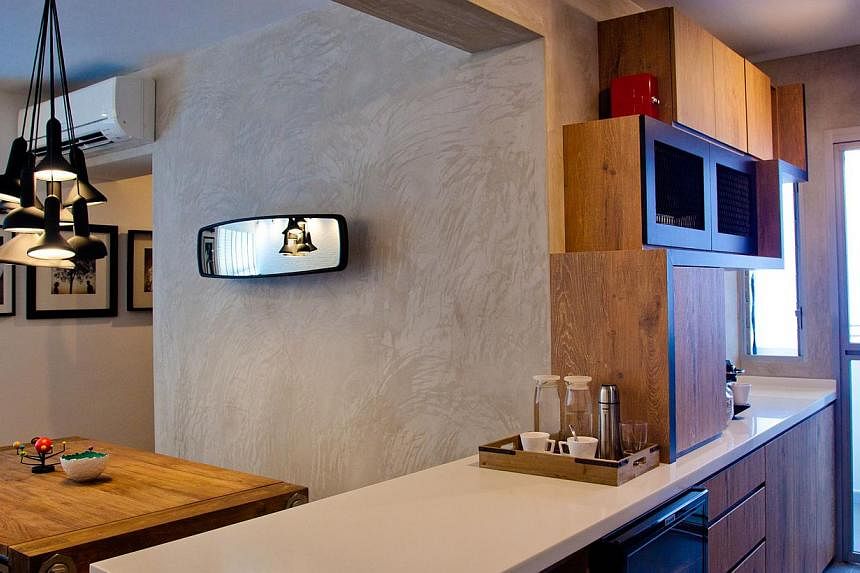When operations supervisor Chuah Teck Leong, 25, and his wife, administrative assistant Sim Yi Ning, 23, were looking for interior design inspirations last year, they fell in love with the spacious look of open-concept kitchens.
Open kitchens are not enclosed by walls, unlike traditional kitchens, and often seamlessly extend into the living or dining room.
No surprise then that the couple chose to go sans kitchen partition wall when designing their new four-room Build- To-Order (BTO) HDB flat in Sembawang last July.
According to the Housing and Development Board, six in 10 new home owners are now choosing to go with an open-kitchen layout, which is part of the HDB's Optional Component Scheme. The slate of options covers flooring, doors and sanitary fittings too.
The HDB has been offering the open-kitchen option for select BTO projects since September 2013, after its 2012 pilot project at Teck Ghee Parkview saw a 70 per cent take-up rate for the open-kitchen layout.
An HDB spokesman says: "Besides giving home owners greater flexibility in terms of design of their home, the option also saves them the hassle and cost of hacking walls if they would rather go for an open-kitchen layout."
And even though the first batch of flats with the open-kitchen option will be ready only in 2017, it has not stopped numerous other home owners from removing walls in their resale and BTO apartments to hop on the open-kitchen bandwagon.
For army regular Delvin Chua, 32, and his wife, financial consultant Jeannie Chua, 30, their open-kitchen layout is a reflection of their lifestyle.
"We love entertaining so it made sense to have an open kitchen that would allow for the kind of interaction," Mr Chua says.
The couple removed all non-essential walls in their four-room resale apartment in Sin Ming and kept the concrete flooring and white scheme throughout, giving their kitchen and living room a seamless and spacious feel.
"Compared with the cramped original layout, the open kitchen allowed for more built-in storage, which is important for a smaller home like ours," he adds.
It seems to be a sentiment shared by many other young couples between the ages of 25 and 35, according to interior designers that Life! spoke to.
Mr Arjan Nijen Twilhaar, 43, principal designer at interior design firm Aiden T., says the new preference among 70 per cent of his younger clients is for breakfast counters and kitchen islands.
"These days, younger couples are well researched and they come to me with pictures of open kitchens from magazines and websites such as Pinterest," he says.
"Plus, because they tend to cook less often and entertain more, they're more receptive to the idea of open kitchens."
Mr Mark Chen, 32, manager at interior design studio Artist Room, agrees, saying: "People used to be worried about the smell of food permeating the home, but nowadays, couples are more health-conscious and tend to bake, steam and air-fry their food, so the lack of walls is less of an issue."
He himself opted for an open kitchen in his four-room BTO apartment in Sembawang as he and his wife, Ms Katy Chong, 31, do only light cooking at home. "The powerful chimney hood we installed above the stove also helps eliminate any lingering food smells," he says.
The biggest draw of an open kitchen, however, seems to be its ability to maximise space, especially when the newer BTO flats are significantly smaller.
Mr Kelvin Teo, 38, principal designer at interior design firm Space Sense Studio, says: "You used to be able to have space for a separate dining table, but now, people want dual-function features such as kitchen islands (which can provide additional storage or be used as a dining table or bar) to save space in a small apartment."
But as good as open kitchens look, they do not always come cheap.
Because they often require customised built-in storage for appliances such as ovens, microwaves and refrigerators, Mr Chen estimates that the total renovation cost, including basic kitchen appliances, removing of walls and carpentry work, can range between $15,000 and $40,000 for a five-room flat, depending on the scale of work and size of the kitchen.
Home owners also need to be careful about their design from the get-go, advises Mr Twilhaar.
"Your kitchen and living area should have design elements that tie them together and you should consider how to hide or display your kitchen appliances. Your kitchen counters will be visible so if they are cluttered, your entire home looks messy."
Another consideration for HDB owners is the layout of the kitchen.
Mr Chen says: "HDB does not allow home owners to change the location of the washbasin beyond the perimeters of the kitchen, so it's important to discuss whether an open kitchen is feasible for the layout of your home."
For those on the fence, a transitional open kitchen - one which still has some separation between the kitchen and living space - can be a good middle ground.
It is also a good option for families who want an open layout, but cook frequently and worry about the smell of food spreading through their home.
Mr Twilhaar says: "By having a sliding glass partition to separate the wet and dry kitchen or opting for only a breakfast bar, you can keep the unsightly elements such as the stove and washbasin out of sight while still getting the airy, spacious feel of an open kitchen.
"It's the best of both worlds."
Why do you like or dislike open kitchens? E-mail stlife@sph.com.sg
Pros and cons of an open kitchen
Pros
- Removing kitchen partition walls can make the home look bigger, let in natural light and give you more space to play with. It is also easier to achieve a uniform look for the cooking, dining and living spaces without partition walls.
- An open layout lets you interact more with family members and mingle with guests. It also lets parents keep an eye on young children while cooking.
- Kitchen islands or breakfast counters can be dual function, providing storage while serving as a dining top and are space-efficient for small homes.
Cons
- Oil, grease and the smell of food can permeate the home, especially if more intensive cooking is done regularly.
- More cleaning is required because the kitchen is not enclosed and dust can settle more easily on kitchen countertops.
- It is harder to reconfigure the kitchen in the future as the storage for kitchen appliances in open kitchens is usually customised and built-in.
- Cluttered kitchen countertops or dirty dishes in the sink can be seen from the living space, making your home look messy.






